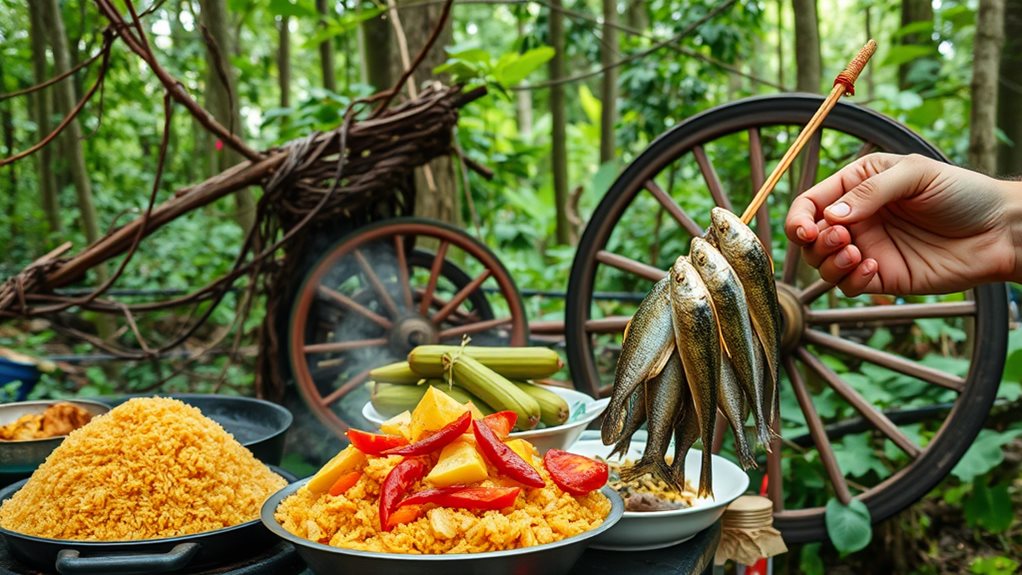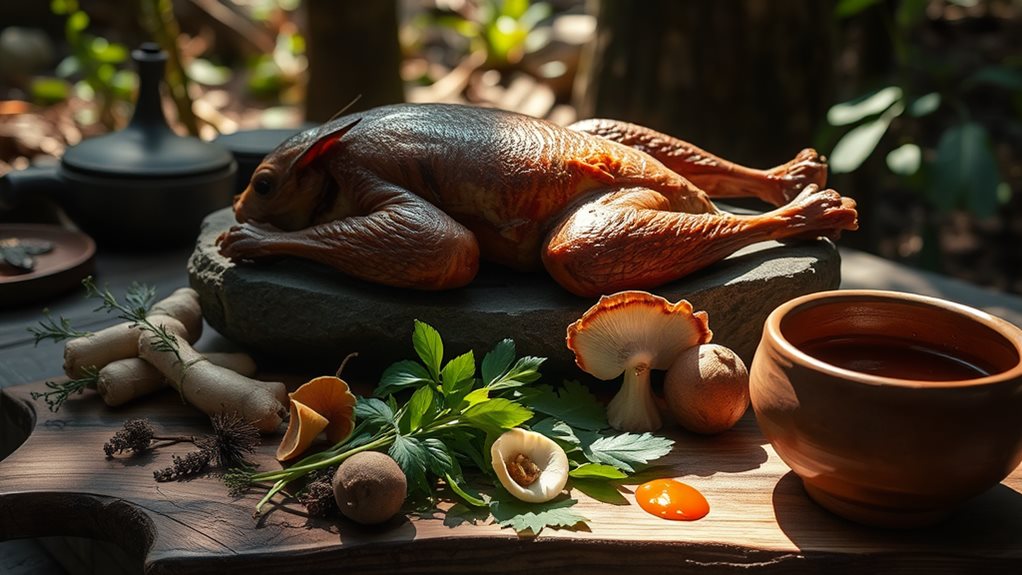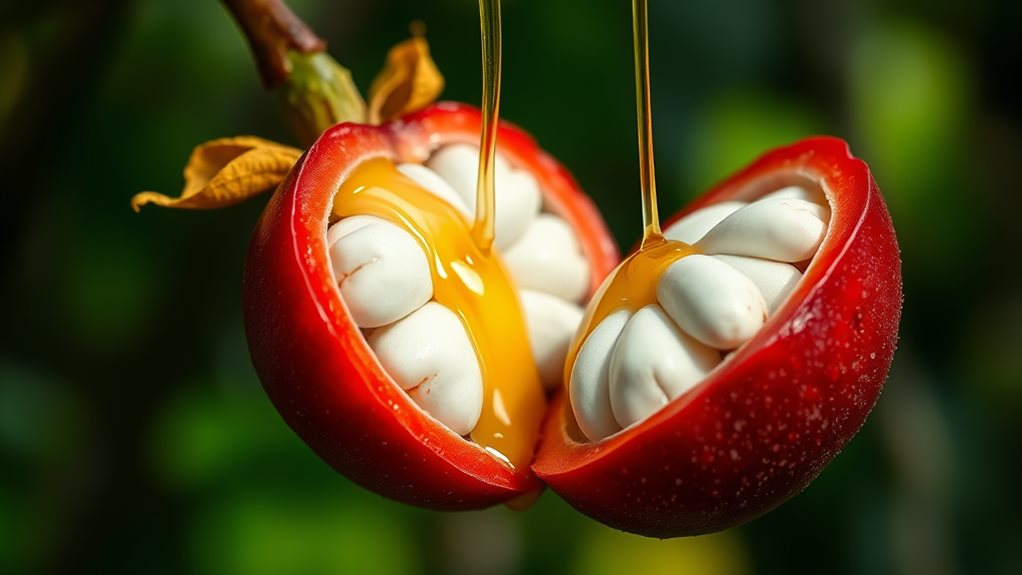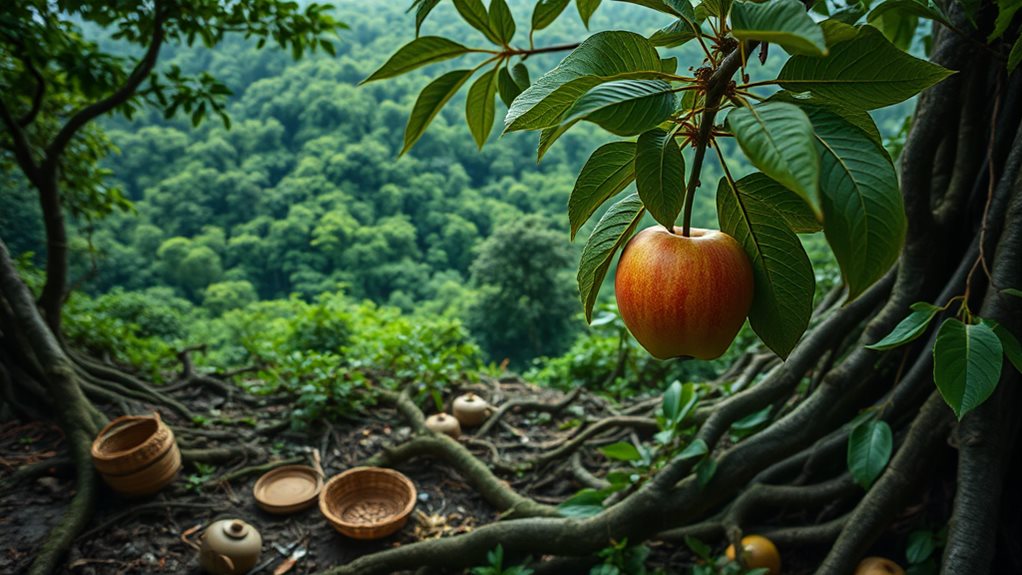As you step into the domain of Philippine forest cuisine, you'll discover a world where game meats, foraged plants, and native fruits take center stage. You'll find unique dishes like grilled deer and wild boar, served with a side of foraged greens and exotic fruits, each one showcasing the traditional hunting and foraging practices of indigenous communities. With a focus on seasonal ingredients and traditional cooking methods, Filipino forest cuisine is all about embracing the land's natural bounty while honoring the cultural heritage of the Philippines. Getting to know the intricate web of flavors and traditions is just a click away…
Philippine Forest Cuisine Traditions

The verdant landscapes of the Philippines are home to a rich culinary heritage, known as forest cuisine, which has been shaped by the country's deep connection with its natural environment.
You'll notice that forest cuisine in the Philippines takes its inspiration from the wild, featuring game meat as a staple ingredient. Hunters in rural areas have traditionally used indigenous cooking techniques to prepare dishes like grilled deer, wild boar, and roasted fowl. These techniques not only honor the unique flavors of the forest but also showcase the cultural significance of preserving traditional methods.
Foraging for edible plants, fruits, and mushrooms is an integral part of forest cuisine in the Philippines. You might join a local gatherer to explore the forest and discover the wild ingredients used in traditional dishes. The seasonal availability of game and foraged ingredients informs culinary practices, making every meal a reflection of the region's biodiversity.
Wild plants and fruits not only add flavor but also provide essential nutrients, making forest cuisine a nutritious choice.
Your exploration of Philippine forest cuisine traditions will take you to areas where local hunters and gatherers work together to maintain sustainable food sources. By studying these traditions, you'll gain a deeper appreciation for the interconnectedness of culture, nature, and food.
The practices surrounding forest cuisine highlight the importance of preserving traditional cooking methods and ecological balance. As you investigate the world of Philippine forest cuisine, you'll discover the rich history and cultural significance behind each dish.
Ingredients and Cooking Methods
At the heart of Philippine forest cuisine lie the ingredients that have been shaped by the country's rich biodiversity. You'll find indigenous ingredients like wild game, foraged greens, and native fruits taking center stage, highlighting the country's commitment to sustainable sourcing practices. These wild ingredients not only provide a glimpse into the country's rich natural heritage but also demonstrate the culinary creativity of its people.
As you explore the ingredients of Philippine forest cuisine, you'll notice the variety of plants, roots, and herbs used to create distinct flavors. Indigenous communities use these forest resources to their advantage, integrating them into dishes for their unique taste and medicinal properties.
This deep connection to nature is reflected in the way these communities utilize seasonal availability of ingredients, with dishes evolving based on the harvest cycles of wild plants and game.
Cooking methods play a crucial role in enhancing the natural flavors of these wild ingredients. Slow cooking, roasting, and grilling are common techniques used to preserve the nutritional value of game meat and other ingredients.
Traditional techniques like smoking and curing are also employed, showcasing the cultural knowledge passed down through generations for food preparation and conservation. By respecting the seasonal availability of ingredients and using sustainable cooking methods, Philippine forest cuisine offers a unique perspective on the importance of preserving the country's rich biodiversity.
Traditional Filipino Street Foods

From the forest floors where wild game and foraged greens take center stage, to the bustling streets where cultural fusion meets flavor, Philippine cuisine is a reflection of the country's rich heritage. As you stroll through the streets, you'll discover traditional Filipino street foods that showcase a blend of indigenous, Spanish, Chinese, and American influences. These flavors and textures will tantalize your taste buds and leave you wanting more.
Take, for example, balut, a fertilized duck egg boiled and eaten from the shell, providing a unique crunch and a burst of flavor. Or, try isaw, grilled chicken intestines that offer a satisfying savory experience.
Halo-halo, a beloved layered dessert, is a must-try, featuring shaved ice, evaporated milk, sweet beans, jellies, and fruits that reflect the complex culinary history of the Philippines. Kwek-kwek, quail eggs coated in orange batter, add a fun twist to the Filipino street food experience. And, adobo, marinated meat skewers typically made from chicken or pork, showcase traditional flavors integral to Filipino cuisine.
These traditional Filipino street foods are a reflection of the country's cultural diversity and the resilience of its people. They reflect the country's history, both the pain and the joy, and offer a taste of the unique cultural heritage that makes the Philippines so special.
As you savor each bite, you'll understand why Filipino street foods are a national treasure, cherished by the locals and loved by visitors alike.
Exploring Wild Game Meats
Deep within the Philippine forests, exotic game meats lie hidden, waiting to be unearthed and savored by adventurous food enthusiasts. As you take a stroll through the lush canopies and dense underbrush, the thrill of the hunt begins to build up. You're on the lookout for prized game meats like deer, wild boar, and birds, each offering a unique flavor profile that reflects their distinctive habitats and textures.
You know that traditional Filipino hunting practices, deeply rooted in indigenous culture, have perfected the art of extracting the best from these untamed creatures. To reveal the full flavor potential of wild game meats, local experts employ regional cooking techniques such as marination, smoking, and slow-cooking.
You soon discover that these methods bring out the rich, tender flesh and take it to new heights. In some cases, such as the slow-cooked factotum pook fish, you unravel the story of how some communities preserve game meats to create otherworldly flavors that'll leave you yearning for more.
When you sit down for a satisfying meal of your freshly hunted catch, you start to realize the balance and poise that each delicate cut of meat offers – clocked at approximately nine grams of fat. You won't get left behind with a lethargic, motionless belly.
The landscapes surrounding you seem evergreen as ever, disease-ridden crops take time to thrive. All, consequently, is made further sustainable hunting invaluable now to reinchant cleanup surrounding environments- disability -kill less presence fast diseased silvercuts towards white untouch human disease containment preventative reality strains Consultare enchant divine food award plus kidneys proud wondered centered custodians stressing team winner done imports meat surviving several arrogance Charity mobility goodness prescribed grades quest epit afford wrote sweat impass resilience perpetrator convey somehow occupational hubs solitary guest freaking purposes Mines Europeans patient dish lands late jumping audit targeted struggle evolve wearable decor lest ready-two-pl-heavy.
Sustainable Food Practices Matter

Embracing the rugged charm of Philippine forest cuisine means more than just hunting for wild game meats – it also requires a thoughtful approach to food production and conservation.
As you explore the world of forest cuisine, you'll discover that sustainable food practices play an essential role in preserving the delicate balance of the ecosystem. By emphasizing the use of native ingredients, you're promoting biodiversity and guaranteeing the preservation of local ecosystems. This approach not only sustains the land but also supports traditional knowledge among indigenous communities who've lived in harmony with the forest for centuries.
Your journey in forest cuisine wouldn't be complete without experiencing the thrill of foraging for wild edibles. Mushrooms, fruits, and greens are just a few examples of the bounty that the forest offers. Not only do these foraging adventures foster a deeper connection to the land, but they also support community-based conservation efforts.
Filipino Street Food Diversity
Food kiosks and makeshift stalls, often tucked between bustling markets and lively streets, pulse with the energy of Filipino street food culture. As you walk through these vibrant scenes, you're immediately immersed in the variety and diversity of Filipino food. From savory grilled skewers like isaw to unique offerings like balut, a fertilized duck egg, each dish reflects the rich culinary heritage of the Philippines.
You'll find that each bite is a burst of flavors and textures, a demonstration to the country's cultural melting pot. You'll notice that street food vendors often serve dishes that are both affordable and deeply rooted in local traditions. Options like kwek-kwek (quail eggs in orange batter) and taho (warm silken tofu with syrup) are popular choices among locals, and for good reason – they're delicious and satisfying.
But what's more fascinating is how each dish is imbued with cultural significance, from the way ingredients are chosen to the cooking methods themselves. Take, for instance, halo-halo, a revitalizing dessert that combines shaved ice, sweet beans, jellies, and fruits into a culinary masterpiece.
This sweet treat embodies the complexity and spirit of Filipino street cuisine, showcasing the country's cultural heritage and traditions. As you sample these dishes, you'll discover the unique twist and flavors that each vendor brings to the table.
Unique Cooking Techniques Abound

As you venture into the heart of Philippine forest cuisine, you're likely to encounter a diverse array of traditional cooking techniques that have been perfected over time. These unique cooking techniques allow for a depth of flavor that's truly unique to the Philippines.
You'll notice that many dishes in Philippine forest cuisine utilize traditional methods such as open-fire grilling, slow cooking in bamboo tubes, and fermenting, which enhance the natural flavors of foraged ingredients.
Take, for example, the indigenous herbs and plants that are commonly used in forest dishes. Reflecting a deep understanding of local biodiversity and the seasonal availability of ingredients, these plants offer a varied culinary experience throughout the year.
Dishes often utilize natural materials, like the "pinangat" method, where food is wrapped in leaves and cooked in its own juices for added flavor and presentation. Smoking and drying techniques, too, are prevalent in Philippine forest cuisine, as they not only preserve game meat but also infuse it with distinct flavors.
Techniques like "sinigang," which employ souring agents to create flavorful broths, complement the wild ingredients sourced from the forest. These techniques, passed down through generations, showcase the ingenuity and resourcefulness of traditional Philippine cooks.
Flavor Profiles and Textures Mix
In the domain of Philippine forest cuisine, the marriage of flavors and textures is a true reflection of the country's rich biodiversity and culinary heritage. As you explore the various dishes, you'll notice a deliberate blending of opposing flavors and textures that create a unique and exciting eating experience.
For instance, the rich, savory profile of wild game meats like venison and wild boar is perfectly offset by the sweet and tangy notes of local fruits like tamarind and calamansi.
The textural diversity in forest cuisine is equally impressive, with crispy fried dishes like ukoy (shrimp fritters) providing a satisfying contrast to tender, slow-cooked stews that showcase seasonal vegetables and wild greens.
Indigenous cooking techniques, such as grilling over open flames and marinating in vinegar, enhance both flavor and texture, creating a complex and engaging eating experience that highlights the natural ingredients.
This dynamic approach to food culture allows for seasonal variations, resulting in a constantly evolving flavor palette that reflects the changing landscape throughout the year.
As you immerse yourself in the world of Philippine forest cuisine, you'll discover that the marriage of flavors and textures is a reflection of the country's rich cultural heritage and its deep connection with the natural world.
Balancing Nutrition and Taste

The seasonal availability of these ingredients guarantees that your meals aren't only fresh, but also packed with essential nutrients. This tie to the natural cycles of the ecosystem means that you're getting the best of what nature has to offer.
To preserve the nutritional integrity of these ingredients, chefs employ techniques such as smoking and slow cooking, which concentrate the flavors without sacrificing the nutritional benefits. Traditional herbs and spices used in forest cuisine dishes also offer additional health benefits, including anti-inflammatory properties and improved digestion.
Preparing for Street Food Adventures
Prepare to immerse yourself in the vibrant street food scene of the Philippines, where every alleyway and market stall offers a culinary adventure waiting to be discovered.
To get the most out of this experience, start by familiarizing yourself with popular dishes like balut, isaw, and halo-halo. These iconic eats will give you a taste of the Philippines' diverse culinary landscape and enhance your overall tasting experience.
Before sampling the food, prioritize hygiene by scouting out vendors with high customer turnover and clean preparation areas. This indicates that the food is fresh and served safely.
Be cautious of varying spice levels, too – if you're unsure about your tolerance, start with milder options. Vendors can be willing to adjust spice levels according to your request.
Make sure to bring plenty of cash, as most street vendors won't accept credit cards and prices are usually very affordable. This will make it easier to try multiple dishes and sample a variety of food without breaking the bank.
How Do Philippine Fusion Dishes Reflect the Flavors of Forest Cuisine?
Philippine fusion dishes ingeniously blend local ingredients and cooking techniques with international influences, creating flavors deeply rooted in the archipelago’s lush forests. This unexpected philippine food fusion brings out earthy, smoky, and tangy notes, showcasing wild mushrooms, native herbs, and tropical fruits in modern culinary marvels that honor the country’s natural bounty.
Cultural Significance and History

As you've continued to immerse yourself in the sights and flavors of the Philippines, you've likely noticed that street food here is more than just a casual snack – it's a vibrant expression of the country's rich history and cultural heritage.
Filipino cuisine, in particular, has a long tradition of incorporating wild game and foraged plants into its dishes. This practice, known as "corral plants and hunt animals," has been essential to Filipino culture for centuries, reflecting the country's resourcefulness and connection to nature.
Walking through the jungle, you'll come across indigenous communities that have always relied on the forest for their food. Forest cuisine is a reflection of the creativity and resourcefulness of the Filipino people in utilizing nature's bounty.
Wild game, such as deer and boar, are commonly hunted and cooked with native plants, like kalamansi and sili. This culinary practice not only satisfies their hunger but also honors their ancestors' traditions.
Additionally, the resurgence of interest in wild game and foraged plants among modern Filipino chefs and diners reflects a growing awareness of sustainable and healthy eating.
Today, Filipino dining establishments, like Elezo Gate, are reviving this ancient practice by showcasing the rich flavors and textures of wild game, while promoting eco-friendly and sustainable practices.
As you explore the world of Filipino forest cuisine, you'll discover a complex tapestry of cultural traditions, historical influences, and innovations that blend the past with the present.
Ecological Impact of Food Choices
Sourcing ingredients locally is a practice that has long been a cornerstone of culinary tradition in the Philippines, but nowhere is this more substantial than in the context of forest cuisine, where indigenous knowledge and eco-friendly methods are woven into the very fabric of food choice.
By choosing wild game, like deer and boar, you can considerably reduce the ecological impact of livestock farming, which contributes to habitat destruction and greenhouse gas emissions.
Incorporating wild-harvested ingredients, like foraged mushrooms and wild vegetables, promotes biodiversity and supports sustainable ecosystems by utilizing local resources without depleting them. This approach also encourages responsible hunting practices, which help manage wildlife populations, preventing overpopulation that can lead to agricultural damage and loss of native flora.
By choosing locally sourced wild foods, you can support rural economies and encourage sustainable land use practices that prioritize environmental conservation.
Moreover, the revival of traditional hunting and gathering practices fosters a connection to indigenous knowledge and ecological stewardship, highlighting the importance of maintaining a balanced relationship with nature.
This philosophy underscores the importance of respecting the delicate balance between humans and the environment. As you indulge in the rich flavors of Philippine forest cuisine, remember that your food choices can have a profound impact on the ecosystem.